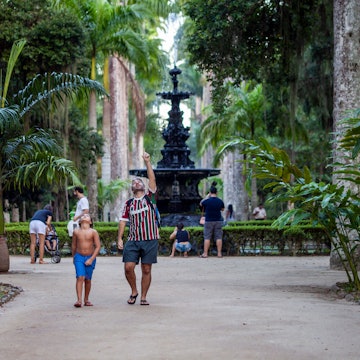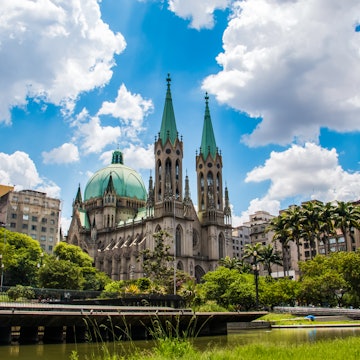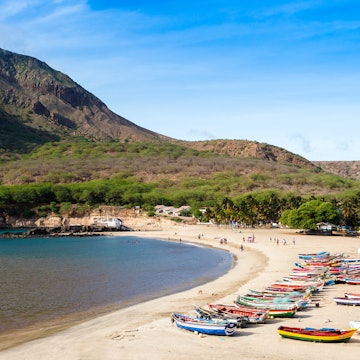

Despite the fact that it's a pricey world city, visiting Rio doesn't have to break the bank – here are our tips for saving some cash © FG Trade / Getty Images
If you're planning a trip to Rio, you might need to budget more than you think – prices in Rio de Janeiro are often on par with travel in parts of the USA or Europe.
This South American cultural capital generally isn't a cheap place to visit – or to get to. Whether you scored a lucky airline deal or are slowly overlanding across South America, you'll want to make your pennies count to get the most out of your stay in the Marvelous City. Here are our tips for navigating Rio on a budget.
1. Handle your housing
Rio de Janeiro isn't an easy swing for the budget traveler. The biggest expense is accommodation – hotels, apartments, and even hostels are similar to European prices.
Getting your accommodation under control makes spending time in Rio de Janeiro on a budget much easier. Try finding a Workaway in the city, volunteering at a hostel in exchange for room and board or renting a room through friends of friends.
Many Brazilians who wouldn't rent their place on Airbnb are happy to let someone stay who has a personal connection (and usually for a much better rate).
Hotel lovers can look for the rare budget hotels in Rio, mostly located in the city center, minus a few gems like the barebones but clean Farfalla Guest House in Botafogo, or Jo&Joe in the Largo do Boticário, which is a half-hotel, half-hostel.
2. Stay in budget-friendly neighborhoods
Some neighborhoods in Rio come with higher price tags, so avoid them if you're looking to save money. The beachfront hamlets of Leblon and Ipanema take the cake price-wise, along with Gávea and Jardim Botânico; these four neighborhoods boast some of the city's most expensive hotels, apartments and restaurants.
Copacabana, Leme or even Barra de Tijuca (now connected by metro) are all more inexpensive options for beach lovers. If you're not bothered about being near the ocean, choose a hip hamlet like Botafogo, Flamengo, Glória or even Santa Teresa.
They all have more agreeable rents, cheaper restaurants, and, with the exception of Santa Teresa, are all easily accessible by metro.

3. Enjoy the local markets
Eating out in Rio can run from R$25-30 to R$100-150 for every meal, which means eating out should be lower on your list when you're limited for cash. A meal out for two can destroy your weekly budget, and even the supermarket can deliver some shocking price tags.
Instead, make the best of one of Rio's most beautiful offerings: weekly farmers markets. Nearly every neighborhood has one (or two, or three), selling fresh fruit and veggies, fish, eggs, meat and often cheese, honey or other locally produced goods, for prices much cheaper than you'll find at a supermarket.
Trade in your restaurant meals for home-cooked food and you'll easily cut your budget in half. As a bonus, some of the markets even double as free entertainment.
The Feira da General Glicério and the Feira da Glória turn into full-day events (on Saturdays and Sundays respectively), with street food, kids' activities, and live music that will keep you going until nightfall.
4. Evaluate your transport options
While taxis and rideshare cars are relatively inexpensive (and are the safest choice late at night), there are many other transportation options that can help you save cash.
Rio's metro, which now runs on three lines and covers the north of the city to Barra de Tijuca, costs R$6.90 per ticket and is fast, convenient and almost always air-conditioned.
There are also public buses that can get you almost anywhere (just beware of traffic), costing R$4.30 for a one-way ride and vans that follow the coastal streets from São Coronado to Copacabana.
If you're not risk-averse, ordering a moto-taxi from your ride-share app is usually half the price of a car.

5. Explore Rio on two wheels
If you're really looking to save money though, a bike is a great way to get around. With a local sim card, you can access the Itaú app and take advantage of the city's orange shared bicycles. A monthly subscription is only R$30 for up to four hour-long rides per day.
There are stations from Centro to Barra de Tijuca and a growing number of bike paths stretching along the city. Even if you're a less confident cyclist, the bike paths along the beach, around the Lagoa or on the Aterro do Flamengo are perfect for any level.
6. Find free music
Rio is the best city for amusing yourself without spending a penny. Brazilians have a term for free things: "0800," or "zero oitocentos," which is the telephone calling code for a free call. Open-air live concerts are practically a Carioca birthright.
Every day of the week there is a samba, chorinho (an instrumental genre originating in Rio), or jazz concert somewhere in the city, and if you're astute, you can also find all-night ragers and headlining shows that take place in public arenas, all free of charge.
Follow nightlife mavens like @segueabella, @aboutcarnaval or the samba focused @ondetemsambajr on Instagram to find out where the party's at on any day of the week (the culturally minded should try @eventos.rio or @agendaculturalrj.)
Even if you are going to pay for an event or party, remember there is almost always an option for "entrada solidaria," Where you bring a kilo of non-perishable food in exchange for a half-price ticket.
7. Check out the museums
Most museums have open entry at least one day a week (visit the newly minted Museu de Amanhã on Tuesdays, for example), and some of them – like the Centro Cultural Banco do Brasil (CCBB) – run events with music, shows, cinema or artisan markets that the public are invited to come in and visit.
You'll also find art galleries across the city that you can visit without paying – from Casa Voa or Carpentaria in Gávea to A Gentil Carioca in the city center.
If you read Portuguese, you can check out the Rio Show section of O Globo newspaper, which offers a weekly list of events, shows and gallery openings.

8. Hike to half-entry
Want to visit Sugarloaf Mountain? Did you know you can climb the first hill on foot instead of paying for the cable car? Not only is it a cool outdoor activity – it cuts the price of the trip in half. Similarly, you can hike to Cristo Redentor – the trailhead is inside of Parque Lage – and the entrance to the site is almost halved as well.
9. Explore the outdoors
Built inside a thriving jungle on the shores of the Atlantic Ocean, nestled in between granite hilltops, with excellent weather year-round, Rio is the perfect place to enjoy the great outdoors every day without opening your wallet.
Spend the morning on the beach, walk, run or cycle around the Lagoa, swim in a waterfall or hike through the Tijuca National Forest, no entry required.
Daily Costs
Bed in an eight-bunk hostel dorm: R$75-R$100
Basic private hostel room for two: R$200-R$250
Self-catering apartment (including Airbnb): R$300-R$500
One-way metro ticket: R$5
Coffee at a cafe: R$8-R$15
Full breakfast: R$25
Açai bowl: R$15-R$40
Prato-Feito (dish of the day for lunch): R$15-R$30
Sit-down dinner for two: R$40-100
600ml beer: R$15-R$25














